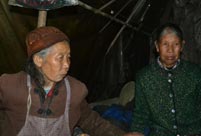

GYIRONG, Tibet, April 27 -- Dawa reverentially lights a ghee lamp in her tent at a temporary camp on the China-Nepal border and murmurs a prayer for her elder sister Yangjain who died in Saturday's earthquake.
Her mother Sonam, 80, sits motionless except for the prayer beads she runs ceaselessly through her fingers.
About 40 km from the epicenter in Nepal, two days after an 8.1-magnitude earthquake destroyed nearly 95 percent of houses in their village, the family is overwhelmed by grief. When their home was destroyed on Saturday, Yangjain, 42, was hit by falling rubble.
"She received emergency treatment at a temporary clinic," Dawa says. "The doctors did their best, but three hours after the quake, she was dead."
Despite her grief, Dawa knelt in front of the doctors in gratitude for their efforts to save her sister.
The quake killed more than 3,000 in Nepal and at least 20 in Tibet, mostly in Gyirong, where Dawa's camp is located, and the neighboring county of Nyalam, both in Xigaze Prefecture. Yangjain was one of three who died in Sale Village, where 16 others were injured.
Across Xigaze, thousands of buildings were destroyed. Almost 25,000 people were made homeless. Landslides and avalanches have made it difficult for rescue vehicles and relief supplies to reach the places where they are needed most.
The survivors are crammed into 25 tents, so preventing outbreaks of contagious disease is paramount. Tsedon, deputy chief of the village clinic, has worked tirelessly along with four colleagues to disinfect the area. They work around the clock in shifts, providing whatever help they can. In Sale, everyone is doing their best to get by.
The first batch of relief supplies arrived on Sunday morning; eight trucks of tents, quilts, food, water and medicine. More supplies are on the way. On Monday, authorities imposed traffic restrictions on roads leading to the affected areas, allowing only rescue and relief vehicles to enter. Aftershocks, landslides and avalanches have cut most roads.
Namtag, 51, uses the traditional long knife carried by most Tibetans to carve a stick into a ladle as his wife cooks tsampa porridge for the whole family. Six-year-old Tenzin Pando cares little about the disaster. He seems to enjoy living in a tent and frolicking with his friends among the ruins.
Only 20 hours after the first shocks, two baby boys were born in tents that served as makeshift delivery rooms. "Congratulations, all is well," Dr. Migmar Norbu of the Sale village clinic said as she handed the newborns to their parents.
Dawa retrieved what she could from the wreckage of her home. Now, 20 ghee lamps glow on a small wooden table in the tent. In the dim light, she mutters prayers of peace for her dead sister, for the health for her mother, and asks for better luck for all her fellow villagers.
 J-11 fighters in air exercise
J-11 fighters in air exercise Beauties dancing on the rings
Beauties dancing on the rings Attendants-to-be join Mr. & Miss Campus Contest
Attendants-to-be join Mr. & Miss Campus Contest Beijing's toughest anti-smoking law takes effect
Beijing's toughest anti-smoking law takes effect Family lives in cave for about 50 years in SW China
Family lives in cave for about 50 years in SW China PLA soldiers operating vehicle-mounted guns in drill
PLA soldiers operating vehicle-mounted guns in drill Blind carpenter in E China's Jiangxi
Blind carpenter in E China's Jiangxi China hosts overseas disaster relief exercise for the first time
China hosts overseas disaster relief exercise for the first time 20 pairs of twins who will become flight attendants in Sichuan
20 pairs of twins who will become flight attendants in Sichuan Obama is sowing discontent in S.China Sea
Obama is sowing discontent in S.China Sea Rescuers work through night to reach cruise ship survivors
Rescuers work through night to reach cruise ship survivors Driving through limbo
Driving through limbo Facing down MERS
Facing down MERSDay|Week